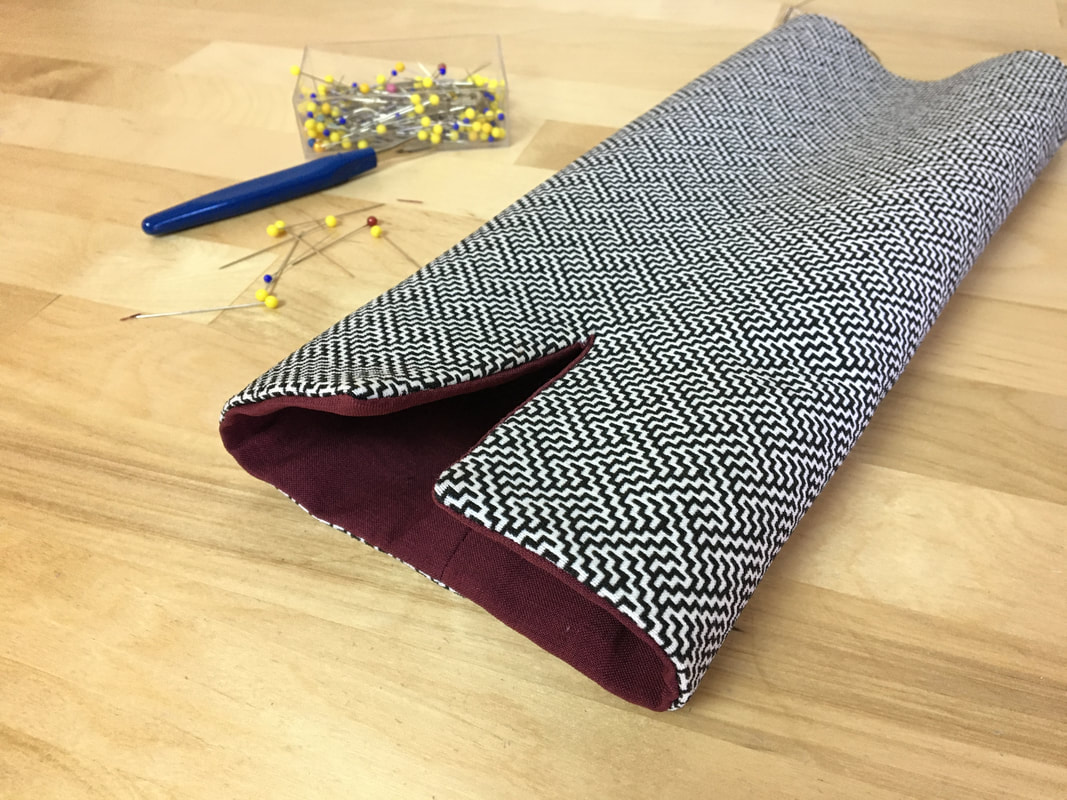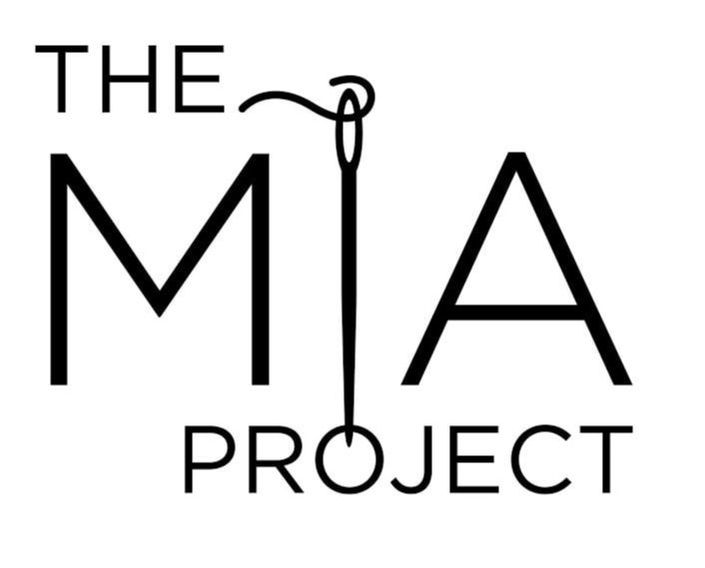|
When I first started sewing, I felt quite intimidated by skirt vents. Over time, I’ve learned that a classic skirt vent looks a lot more complicated to sew than it actually is. For those that don’t know, a vent is a type of slit usually added to the back of a non-stretch (woven) skirt or dress in order to add flexibility when walking or sitting. Although they can alter a garment aesthetically, vents have a mostly functional use. They are necessary for skirt/dress bottoms that are more form fitted with fabrics that do not provide enough stretch for movement. Vents are usually understated and tend to blend into seams- conventionally added to center back seams. Given that they have a purely functional purpose, they should stay closed and blend into the garment’s design when stationary and separate slightly to allow for the necessary amount of flexibility when moving. Unlike a slit, it is rare to find a skirt or dress vent designed to stand out aesthetically; however, a vent is visually a somewhat tailoring staple thus its absence can sometimes signal a lesser quality tailored item. Regardless of whether you’ve attempted to sew a vent before, like a sleeve cuff, this is one of those elements that is bound to come up at one point or another. When it does come up, your sewing patterns will dictate the technique to use for the garment’s vent construction. For the most part, a seam that houses a vent will usually have an outwards extension at the bottom where the vent is located. This extension expands away from the seam allowance and can measure anywhere from 1.5 to 3 inches depending on the fabric, vent's clean finishing techniques and the rests of the seam that houses it.
Given this option, the transition from the regular seam allowance at the top to the extension at the bottom, can be a small curve or sharp straight edge. The tricky part is often clean finishing this transitional edge, especially when featuring a sharp inward corner. For that reason, today I’ll show you the easiest of the two: the curved transition. Regardless of what your vent sewing patterns look like (and whether the extension has a sharp corner or curved edge), you can adapt the technique I’ll show you below to sew any style vent. If you follow all the steps consecutively, you’ll learn how to sew a skirt vent in just a matter of minutes!
3 Comments
In today’s tutorial I will show you how to sew something a bit more complicated- A surplice style summer floral dress with front and hemline lined ruffles. Due to the dress’ extensive construction steps, I’ve divided the tutorial in two parts. Today will cover Part 1 which includes fusing the interfacing pieces, pinning and sewing the darts, aligning and sewing the preliminary seams, sewing the individual ruffles, aligning the surplice front pieces, sewing the top ruffle to the dress’ front opening edge, and sewing and clean finishing the all-in-one facing. That’s certainly enough information to take in for one tutorial! What makes this dress design special is its cross between a casual style and a more tailored structure. The ruffles are fully lined with a contrast color silk fabric. For that reason, they have nice body while remaining draped and feminine. My favorite design element is of course, the surplice cut which I find is always flattering. I drafted the sewing patterns using my basic dress blocks. Although I did not cover the entire pattern drafting process in a tutorial, I did capture the detailed steps for drafting the circle ruffle sewing pattern used in this dress design. If patternmaking sparks your interest, you can check out the full tutorial here: How To Make A Pattern For A Circle Ruffle. The resulting patterns for this dress are uniquely shaped and include both full and cut on fold style. For a tutorial on how to cut these pattern pieces efficiently, saving fabric and eliminating waste, check out these useful tips: Cutting Sewing Patterns To Optimize Fabric Efficiency. Now that the dress patterns are cut and all markings are transferred onto each fabric piece, let’s get started on the fun part: Sewing the summer ruffle dress!
Last week I showed you how to draft a sewing pattern for a circle ruffle; Today, I’ll walk you through the process of actually sewing it! The ruffle style described below is part of a summer dress featuring a draped floral fabric and surplice structure on both top and bottom portions (full sewalong to come!).
I’ve had a bit of an obsession with ruffles this summer but courtesy of a hectic schedule, I never actually got around to sewing this bright floral dress. Here I am, beginning of November and I’m determined to finalize it at all cost! From a design standpoint, what makes this summery dress extra special are the asymmetrically positioned circle ruffles. To take it just a step further, the ruffles are fully lined for a higher quality, cleaner finish.
Circle ruffle edges can be finished a number of different ways although the chosen technique is limited by their pronounced curved edges. To give you a comparison- gathered ruffles have straight edges thus are much easier to handle in the sewing process. Vise versa, circle ruffles are only able to withstand a limited amount of finishes.
Regardless of the technique used, a circle ruffle’s lengthwise edges should always have a small seam allowance. Due to how curved these edges are, a short seam allowance provides more control and flexibility. Conventionally, the seam allowance for top and bottom edges is ¼” or less. If the ruffles are not finished with lining, the outer edges (bottom of the ruffle) are usually double folded and stitched in a baby hem. For a less expensive option, they can also be serged, folded once and top-stitched.
Lining circle ruffles on the other hand, provides a more tailored, high quality finish. I personally find it to be the easier option even though it does require an additional lining layer. Lining also provides some nice design flexibility. You can use contrast color/print fabric (like I did in the steps below) to add more visual 3-dimensionality and uniqueness to your garment.
Lining a ruffle can also provide a way to control structure. If you want a stiffer, more structured drape you can use a thicker lining fabric. Vice versa, for a more draped, flexible look, line the ruffle with a lightweight, thin fabric. I used a (gray) silk crepe de chine for mine thus maintaining the ruffle’s lightness and flexibility.
The circle ruffle in today’s tutorial will be sewn into a faced seam. Not only will the facing provide a higher-quality finish, you’ll find that it's also fairly simple to sew!
Before getting started, isolate all the ruffle pieces and align them next to each other. Make sure you understand which edges will be sewn into the garment’s seam and which correspond to the ruffles’ bottom.
Spotting the difference should be fairly easy: The edge corresponding to the seam is always the inner short one; Conversely, the ruffle's bottom edge is longer and more curved. The lining layer should be identical to the ruffle with the fabric face sides mirroring each other.
Last but not least, make sure you identify the garment’s seam which will house the lined ruffle. Mine is the very top edge of the front surplice layer. The lined ruffle is self-finished on one end and sewn into the dress side seam on the other (more on this below). Needless to say, understanding how all the pieces fit together is much easier in the sewing process so let’s get started!
Optimizing your fabric surface area during the cutting process is perhaps one of the most important concepts in garment manufacturing. We may not worry much about it when sewing at home, but the truth is, using the least amount of fabric will not only save money but will also minimize waste. I don’t know about you, but if I don’t optimize my pattern alignment for least amount of fabric use, I end up with awkwardly shaped remnants that usually find their way into the trash bin. Every little bit contributes to more waste and more money down the drain.
Luckily, there are techniques to habitually introduce at home which will allow you not only to cut down on the yardage purchased but also minimize the amount of unusable pieces left after the sewing patterns have been fully cut. These are concepts used on the manufacturing level and should technically be considered official rules for cutting and aligning fabric in the dressmaking process.
Correct pattern alignment is dependent on two important factors: selvage edge and the patterns’ grainline. These two elements work together to guide in the proper alignment scheme. Your critical thinking comes into play when putting all the pattern pieces next to each other such that they:
1. Are as close as possible to the selvage edge.
2. Are aligned as close as possible to one another in accordance with the patterns’ grainline.
3. For cut on fold type patterns, the fabric is folded just enough to account for the sewing pattern width (edge to edge) and not more.
If you enjoy puzzles, you will definitely love the pattern cutting portion of the sewing process. In the example below, I will demonstrate each one of the three concepts described above using a set of surplice style dress patterns. By the way, a full sewing tutorial on this surplice ruffle dress will be up on the blog soon!
There are many instances in dressmaking when you’ll be forced to replace that convenient machine sewing needle with a much slower hand sewing one. In the case of sewing decorative appliques, you may be asking yourself- why would I ever need to attach them by hand when I can easily topstitch them on the sewing machine? When it comes to decorative garment applications, things are not always as simple as they appear. In many instances, the only way to safely sew an applique is by hand using a sort of modified slip stitch method. In some scenarios, you may even save some time by opting for hand stitching in lieu of machine stitching altogether. Here are some situations when hand sewing appliques is not only recommended but also essential to the structure, finish and look of a garment:
In today’s tutorial, I’ll go a step further by showing you how to actually extract an applique from a lace or ornamental fabric and hand stitch it to the surface of a silk crepe de chine. The need for this comes up quite often when you can’t find the right pre-cut appliques on the market. In that case, it is totally acceptable to cut your own from a suitable fabric. I’ll show you this simple process below.
Don’t you love simple sewing techniques that when finished, look like hours of hard work? In today’s tutorial, I’ll show you one such technique- sewing a faced slit to the bottom edge of a sleeve. I chose to add this finish to a sleeve as this is one of its most conventional uses. A faced slit looks beautiful on heavier weight pieces like blazers and coats. There is undeniably a clean, tailored aspect to anything that features a facing. Using a facing to add a slit not only provides an elevated, high quality finish, it is also a great way to add an opening into the surface of fabric without relying on an actual seam. There is no argument that slits which open from a seam are certainly more durable, but as in the case of a sleeve cuff, a shorter faced slit is a great option for areas that don’t require as much movement and stretch. The key word here is “shorter”. Seamless faced slits usually function and hang best at a shorter length as they are more tailored and structured in nature. Of course, a slit that originates from an actual seam can also be faced or lined. This sort of slit style however is an entirely different technique than what we’ll talk about today. Here are some important notes on facings before we move on to the sewing steps below:
|
The Blog:A journey into our design process, sewing tutorials, fashion tips, and all the inspiring people and things we love. Doina AlexeiDesigner by trade and dressmaker at heart. I spend most of my days obsessing over new fabrics and daydreaming new ideas. Sadie
Executive Assistant & Client Relations Manager Archives
November 2019
Categories
All
|
-
Sewing Tutorials
-
Basics
>
- Aligning Pattern Grainlines To Fabric
- Preparing Fabrics For Sewing
- Pinning Sewing Patterns To Fabric
- Placing Sewing Patterns On Fabric For Cutting
- Rotary Cutters or Fabric Scissors?
- Cutting The Sewing Patterns
- What Are Notches And How To Use Them In The Sewing Process
- Transferring Notches From Pattern To Fabric
- Transferring Seamlines to Fabric
- Staystitching
- Backstitching: A Complete Guide
- Hand Basting: A Complete Guide
- Sewing Continuous Bias Binding
- Darts >
-
Sewing Seams
>
- The Basics Of Seams And Seam Allowance
- How To Sew A Straight Seam
- Sewing Curved Seams
- Sewing Corner Seams
- Trimming And Grading Seam Excess
- Notching/Clipping Seam Allowance for Tension Release
- Sewing Topstitched Seams
- Sewing Corded Seams
- Sewing A Slot Seam
- Sewing A Gathered Seam
- Sewing Bias Seams
- Sewing Seams With Ease
- Sewing Seams With Crossing Seamlines
- Sewing Unlike Fabric Seams
- How To Iron Seams: Ironing Tools And Conventions
- Sewing With Knit Fabrics
- Understanding Stitch Length And Tension
- Sewing Unique Fabric Seams
-
Seam Finishes
>
- Seam Finishing Techniques - Overview
- Applying A Pinked Seam Finish
- Applying A Bias Bound Seam Finish
- Serging And Zigzag Seam Finishes
- Sewing A Self-Bound Seam Finish
- Sewing A French Seam Finish
- Sewing A Hong Kong Seam Finish
- Sewing A Mock French Seam Finish
- Sewing A Turned-and-Stitched Seam Finish
- Sewing Overcast Hand-Applied Seam Finishes
- Sewing A Flat Felled Seam
- Sewing A Hairline Seam Finish
-
Hem Finishes
>
- Garment Hem Finishes: Overview
- Sewing A Double Fold Hem Finish
- Sewing A Single Fold Hem Finish
- Sewing Bound Hem Finishes
- Sewing An Exposed Double Layer Bound Hem
- Sewing A Folded-Up Bound Hem with Pre-folded Binding
- Sewing A Hong Kong Hem Finish
- Sewing A Band Hem Finish
- Sewing A Bias Faced Hem Finish
- Sewing A Twill Tape Hem Finish
- Sewing A Rolled Hem Finish
- Sewing A Shaped Hem Facing
- Using Fusible Hem Tape And Webbing
- Finishing A Lace Fabric Hem
- Finishing A Leather Hem
- Sewing Faced Hem Corners
- How To Finish Lining At The Hem
- Finishing Fabric Corners by Mitering >
- Interfacing A Hemline: Lined And Unlined Examples
-
Sewing Pockets
>
- Curved Patch Pocket With Flap
- Unlined Square Patch Pockets
- Lined Patch Pockets: Two Ways
- Extension On-Seam Pockets
- Separate On-Seam Pocket
- Front Hip Pockets
- Bound Double Welt Pocket
- Double Welt Pocket With Flap
- Self-Welt Pocket (Using Single Fabric Layer)
- Slanted Welt Pocket (Hand-Stitched)
- Faced Slash Pockets: Overview >
-
Sewing Zippers
>
- Sewing Zippers: General Information
- Sewing A Centered Zipper
- Sewing A Lapped Zipper
- Sewing An Invisible Zipper
- Sewing A Fly Front Zipper
- Sewing A Closed-End Exposed Zipper (No Seam)
- Sewing An Exposed Separating Zipper
- Sewing Hand Stitched Zipper Applications
- Sewing A Zipper Underlay
- Sewing A Placket-Enclosed Separating Zipper
- Sleeveless Finishes >
-
Neckline Finishes
>
- Sewing A Neck Shaped Facing
- Sewing An All-In-One Neck Facing
- Neck And Garment Opening Combination Facings >
- Sewing A Bias Faced Neckline Finish
- Sewing A Band Neckline Finish
- Bound Neckline Finishes: Overview >
- Sewing A Semi-Stretch Strip Band Neckline
- Ribbed Neck Band And Classic Turtleneck
- Decorative Neckline Finishes >
- Finishing Facing Edges >
-
Extras
>
- A Complete Guide on Interfacing
- Sewing Bound Spaghetti Straps
- Sewing Spaghetti Straps To A Faced Neckline
- Sewing Ruffles: Overview
- Patterning And Sewing A Circle Ruffle
- Sewing A Gathered Heading Ruffle
- Sewing Double Layer Gathered Ruffles
- Sewing A Gathered Ruffle Into A Seam
- Sewing A Gathered Ruffle To A Fabric Edge
- Sewing A Fabric Surface Slit
- Sewing A Slit Seam
- Hand-Applied Straight Stitches
- Hand-Applied Blind Stitches
- Hand-Applied Overedge Stitches
- Hand-Applied Tack Stitches
- Hand-Applied Decorative Stitches
-
Basics
>
- Custom Bridal
- Custom Apparel
- About
- Blog
Services |
Company |
|




 RSS Feed
RSS Feed

